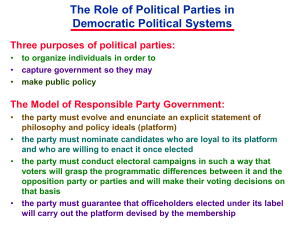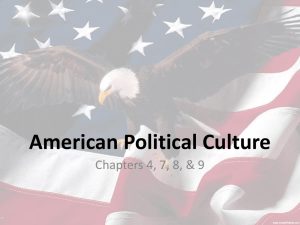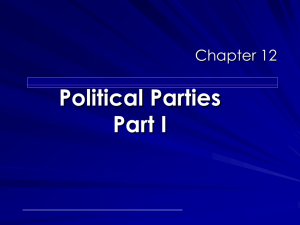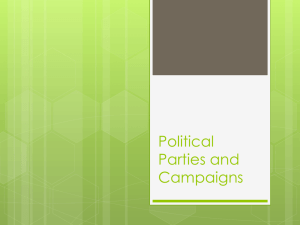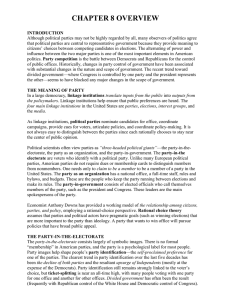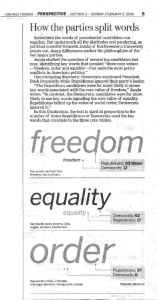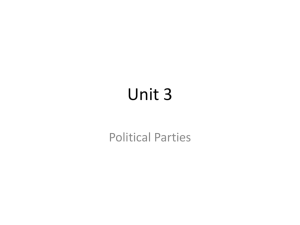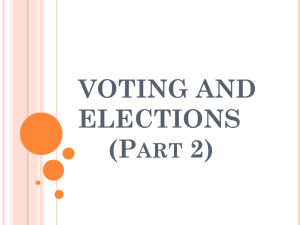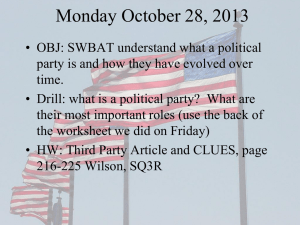The Six Party Systems
advertisement
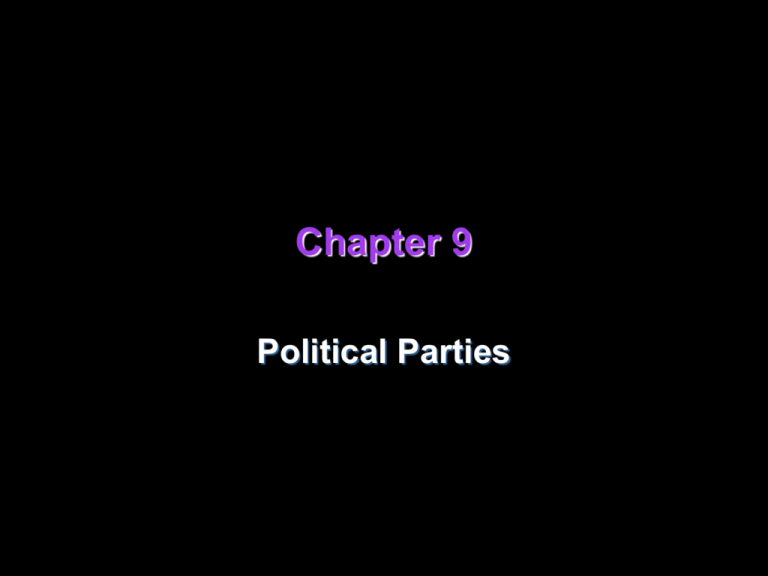
Chapter 9 Political Parties The Functions of Political Parties (Note: Parties have consistently grown weaker in each of the functions) • • • • • • • • • Nominate Candidates Raise and Spend campaign funds Register voters Simplify decisions for voters Unify diverse interests Act as moderating influence on government Reduce diffusion of power in government Provide patronage Inform public through party platforms The Rise and Decline of Political Parties Origins • • Dangers of factions- Fed #10 Washington’s warning -“baneful effects of the spirit of party.” Nevertheless, parties necessary • – Hamilton’s financial plan and support for Jefferson’s Louisiana Purchase. • The Party, as a unifying force, was necessary to overcome the systems of separation of powers and checks and balances that divide government. The Rise and Decline of Political Parties Historical development: the Six Party Systems in American History The Six Party Systems • 1796-1824: the 1st party system: Federalists v. Jeffersonian Democratic-Republicans – • Republicans’ success and Federalists’ demise 1828-1856: the 2nd party system: Jacksonian Democrats v. Whigs – John Quincy Adams --election went to the house, where Speaker Henry Clay gives his support Adams makes Clay Secretary of State…”heir to the presidency.” • • Jackson (Old Hickory) is “wronged” Grassroots organization of the Democrats Whigs (party in England opposed to the king) springs up, implying that Jackson is acting the part of a monarch The Six Party Systems • 1860-1892: the 3rd party system: Republican dominance as the party against slavery and party that kept the union together – Jacksonian system unable to survive slavery and sectionalism New Republicans became dominant because of: – • • Civil War Republicans rely on Union pride Bryan’s alienation of Northern Democrats in 1896 The Six Party Systems • 1896-1928: 4th party system: second period of Republican dominance with its coalition of big business and the working classes against the Democratic rural interests – – – – – – – Era of reform- Progressives push measures to weaken parties Primary elections Nonpartisan elections at city and sometimes state level Strict voter registration requirements Civil service reform Initiatives and referendum Effects: Reduction in worst forms of political corruption, weakening of all political parties and “reduction” of voter turnout The Six Party Systems • 1932-1964: the 5th party system: – – Democratic dominance begun under FDR and the New Deal FDR’s grand coalition (New Deal coalition) included urban dwellers, labor unions, Catholics, Jews, the poor, Southerners, Blacks, farmers The Six Party Systems • 1968-present: the 6th party system: Era of Divided Government. – Much split-ticket voting – Presidents of one party (typically Republican) with Congresses of the opposite party (typically Democratic). – An era of party dealignment, as voters are moving away from both parties and are increasingly independent Realigning (critical) elections• Long term change in alignment: – – Definition: periods when a major, lasting shift occurs in the popular coalition supporting one or both parties. Examples: 1800, 1828, 1860, 1896, 1932, and some believe 1980but we have to think about why Reagan was elected Parties solidify who they represent • Representation – Republicans represent traditional middle class-more conservative Democrats represent new class-more liberal Democrats hurt since traditional middle class closer in opinions to most citizens – – • To become more competitive, Democrats adopt rule changes – In 1988, number of superdelegates increased while special interest caucuses decreased 1992 rules: – • • • Proportional representation implemented States that violate rules penalized Conventions today only ratify choices made in primaries State and Local Levels • Power distribution: Must look at incentives to understand the organization of state/local parties – The Machine Money, Money…Money! • • The Spoils System: patronage jobs “temporary” jobs awarded to loyal party members. – – • • – Loyalty shown on election day when individual would produce 10 votes for the candidate. in the case of Richard Daley’s Chicago party machine, these individuals would be expected to donate 5% of their income Kickbacks etc Party welfare system response to the spoils system? Two-Party System – Why such a permanent feature? • • Plurality System: the winner is that person who gets the most votes, even if he or she does not get a majority of all votes cast • Electoral systemwinner-take-all and plurality system Opinions of voters—two broad coalitions work, although times of bitter dissent State laws have made it very difficult for third parties to get on the ballot (e.g. Washington’s top two primary) Reasons for third party campaigns • • Raise issues rather than win elections Influence the outcome of presidential elections (1992!!, 2000!!!) Parties versus voters • Democrats: have won more congressional elections than presidential contests – – • Candidates are out of step with average voters on social and taxation issues So are delegates.., and there's a connection Rank-and-file Democrats and Republicans differ on many political issues – • But differences are usually small Delegates from two parties differ widely on these same issues – – Delegates (and candidates) need to correspond with views of average citizens But candidates must often play to the ideological extremes to win delegate support.
